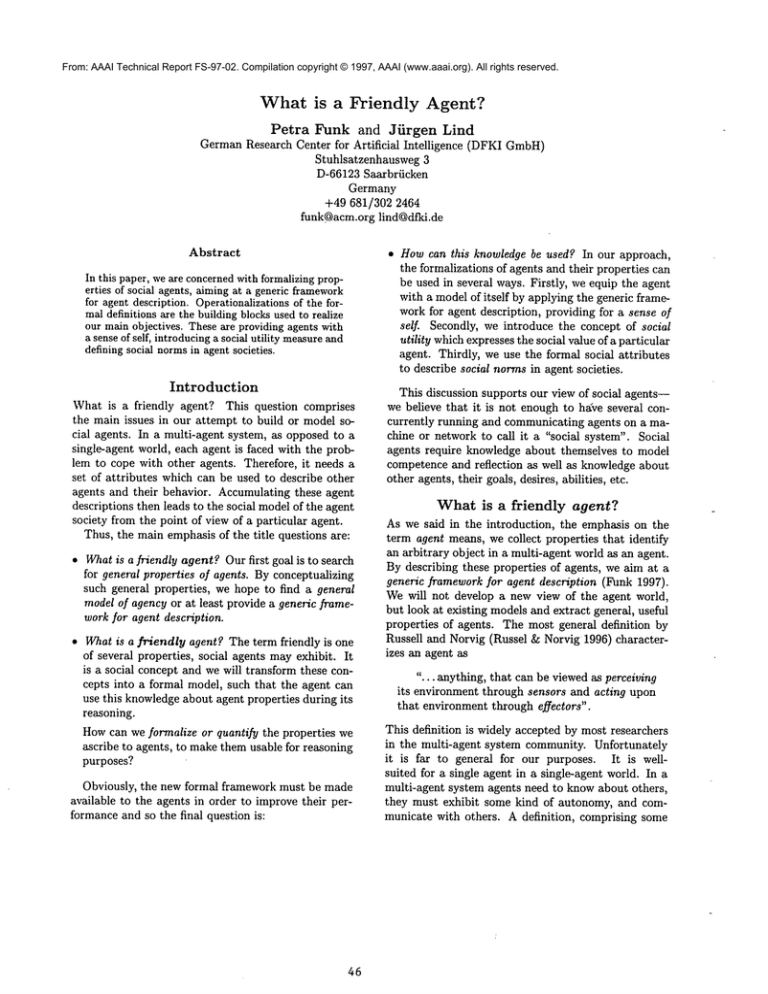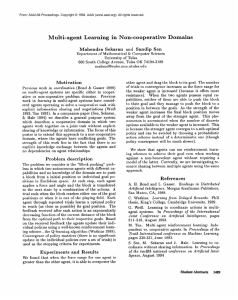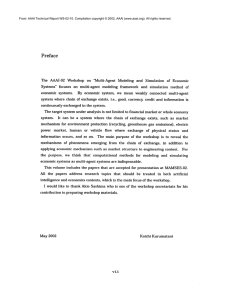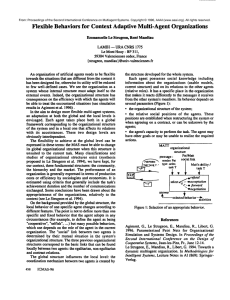
From: AAAI Technical Report FS-97-02. Compilation copyright © 1997, AAAI (www.aaai.org). All rights reserved.
What is
a Friendly
Petra Funk and Jiirgen
Agent?
Lind
GermanResearch Center for Artificial Intelligence
Stuhlsatzenhausweg 3
D-66123 Saarbriicken
Germany
+49 681/302 2464
funk@acm.orglind@dfki.de
Abstract
In this paper, weare concernedwith formalizingproperties of social agents, aimingat a generic framework
for agent description. Operationalizationsof the forreal definitions are the building blocksused to realize
our mainobjectives. Theseare providing agents with
a sense of self, introducinga social utility measureand
definingsocial normsin agent societies.
Introduction
What is a friendly agent? This question comprises
the main issues in our attempt to build or model social agents. In a multi-agent system, as opposed to a
single-agent world, each agent is faced with the problem to cope with other agents. Therefore, it needs a
set of attributes which can be used to describe other
agents and their behavior. Accumulating these agent
descriptions then leads to the social modelof the agent
society from the point of view of a particular agent.
Thus, the main emphasisof the title questions are:
¯ Whatis a friendly agent? Our first goal is to search
for general properties of agents. By conceptualizing
such general properties, we hope to find a general
model of agency or at least provide a generic framework for agent description.
¯ What is a friendly agent? The term friendly is one
of several properties, social agents mayexhibit. It
is a social concept and we will transform these concepts into a formal model, such that the agent can
use this knowledgeabout agent properties during its
reasoning.
Howcan we formalize or quantify the properties we
ascribe to agents, to makethemusable for reasoning
purposes?
Obviously, the new formal framework must be made
available to the agents in order to improvetheir performanceand so the final question is:
46
(DFKI GmbH)
¯ Howcan this knowledge be used? In our approach,
the formalizations of agents and their properties can
be used in several ways. Firstly, we equip the agent
with a modelof itself by applying the generic framework for agent description, providing for a sense of
self. Secondly, we introduce the concept of social
utility whichexpresses the social value of a particular
agent. Thirdly, we use the formal social attributes
to describe social normsin agent societies.
This discussion supports our view of social agents-we believe that it is not enough to halve several concurrently rtmning and communicatingagents on a machine or network to call it a "social system". Social
agents require knowledge about themselves to model
competenceand reflection as well as knowledgeabout
other agents, their goals, desires, abilities, etc.
Whatis a friendly
agent?
As we said in the introduction, the emphasis on the
term agent means, we collect properties that identify
an arbitrary object in a multi-agent world as an agent.
By describing these properties of agents, we aim at a
generic frameworkfor agent description (Funk 1997).
Wewill not develop a new view of the agent world,
but look at existing modelsand extract general, useful
properties of agents. The most general definition by
Russell and Norvig (Russel &Norvig 1996) characterizes an agent as
"... anything, that can be viewedas perceiving
its environment through sensors and acting upon
that environment through effectors".
This definition is widely accepted by most researchers
in the multi-agent system community. Unfortunately
it is far to general for our purposes. It is wellsuited for a single agent in a single-agent world. In a
multi-agent system agents need to knowabout others,
they must exhibit some kind of autonomy, and communicate with others. A definition, comprising some
¯ they are given from a global perspective and not
from the view of an individual agent within a multiagent system and
more of these features (Greenet al. 1997) characterizes
agents as
"... a computational entity which
¯ acts on behalf of other entities in an autonomous fashion
¯ performs its actions with some level of proactiveness and reactiveness
¯ exhibits somelevel of the key attributes of learning, cooperation and mobility."
¯ the focus of attention lies more on technical aspects
of an agent and not on social issues.
This definition is more appropriate for agents in a
multi-agent system, it comprises cooperation and action on behalf of some other entity. In order to act
correctly on someone’sbehalf, an agent requires knowledge about this entity. For cooperation with other
agents knowledgeabout them is not only useful, but
necessary. Such knowledgecan be described by social
concepts. Autonomyand pro-activeness or reactiveness are also required as key attributes of agency.
It is very hard to describe general properties of objects that make them agents, Weit] (Weii] 1995) addresses this by listing a minimum
of properties an agent
needs to have to be accepted as agent: reactivity, situatedness, pro-activeness and deliberation, rationality,
mobility, introspection, veracity, and benevolence.
The last two definitions are more useful for characterizing agents in a multi-agent system than the first
one. Still, they lack an important issue we think essential for agents in a multi-agent world: knowledgeabout
others as well as self awareness. The underlying benevolence assumption allows for easier for communication
and cooperation amongagents, but is in fact unrealistic
for real-world applications (Rosenschein &Genesereth
1985). This leads to posing our initial question with
different emphasis:
What is a friendly
agent?
Friendly, being one of several useful social properties
of social agents, is in our humanhorizon, a positive
personality trait. In fact, we seek help from friendly
people, rather than from unfriendly ones. But, how
can an agent use such social concepts for building a social model of its environment? Conceptualizing fuzzy
properties of agents is not enough, we need to formalize these concepts in a way, that an agent can use
them for its reasoning process. An approach to formalize properties of agents was taken in (Goodwin1993).
The author uses the Z specification language to formalize attributes such as "successful", "capable", "reactive", etc. Furthermore, his definitions are based
purely on the externally accessible parts of the agent.
However,the major problems with the definitions presented there are:
47
Weaim at formalizing social terms with emphasis on
properties of agents in a multi-agent system from the
perspective of an agent within the multi-agent system
and not from a global point of view.
Toillustrate the inherentdifficulties of this task, consider the following situation: every humanbeing has
a moreor less clear idea of any descriptive attribute.
The problem we are faced with is, that this idea is
madeup of a large numberof personal values, desires
and experiences. Besides the difficulty to identify all
factors which makeup the term, the set of factors may
be inconsistent or even contradictory. Therefore, we
need abstract definitions of the terms used in everyday life. Consider the following attempts to define the
attribute "cooperative" from the point of view of a
particular agent:
Definition 1 (cooperative) An agent is cooperative
if it’s actions do not conflict with my goals.
Obviously,this definition is very handyat first sight,
because it enables the agent to classify the other agents
easily. Onthe other hand, does this definition capture
what a human calls "cooperative"? What about the
case whenan agent to be classified does not even know
that there are other agents present? Clearly we do
not want to call an agent "cooperative" which is not
aware of other agents. Consequently, we need a more
elaborate definition:
Definition 2 (cooperative) An agent is cooperative
if it knowsabout my goals and its actions do not conflict with them.
This extension of definition 1 fixes the bug, but it
also introduces an additional problem: how can the
classifying agent tell whether the other agent knows
about its goals? Furthermore, what about an agent
which knows about my goals but its own goal do not
force it to cooperate simply because there is no potential conflict? Again such an agent is not what we
call "cooperative". Therefore, a further refinement is
needed:
Definition 3 (cooperative) An agent is cooperative
if it knowsabout my goals, its owngoals are potentially
conflicting with mine and its actions lead to the least
possibleconflicts.
Althoughthis definition does not capture the entire
term (e. g. it does not include joint action selection of
the two agents), it maysuffice as an approximation. If
we trace the developmentfrom definition i to definition
3, we see that the prerequisites have changed dramatically from no knowledgeabout the other to mutual goal
recognition andconflict detection.
This examples illustrates the problems of the task
to define social attributes from the point of view of a
single agent. Definitions which are able to capture the
major part of a social concept need powerful support
mechanisms(such as goal recognition techniques)
be used efficiently. It is therefore very important to
identify a set of useful attributes and to provide formal
definitions for themon various levels of abstraction.
The social attributes are needed in this respect to
describe and communicatesocial norms.
Conclusion
In the previous sections, we have outlined the need
for an explicit representation of social knowledge.By
conceptualizing properties of social agents we aim at
a generic framework for agent description. In order to assess agents and their social attitude in a
multi-agent system the social concepts must be made
operational. Finally this new knowledgeand reasoning can be used for giving the individual agent the
self awareness needed in a social system, enabling it
to asses other agents and describe and communicate
social norms as well as meeting these norms. This
will lead to what we understand by socially intelligent
agents.
What for?
Nowthat we have outlined the need of social attributes
and the difficulties of obtaining operational definitions
of them, we will present our ideas for the usage of these
attributes. The main ideas are:
References
Chaib-draa, B. 1997. Connection between micro and
macro aspects of agent modeling. In MAAMAW’gZ
Fagin, R.; Halpern, J. Y.; Moses, Y.; and Vardi, M. Y.
1996. Reasoning About Knowledge. MIT Press.
¯ Sense of self. As has been stated by Marsh (Marsh
1995), a very important feature of a socially intelligent agent is a sense of self--the ability to see oneself
as others see one. This allows an agent to behave
in way it believes acceptable to others. A generic
framework for agent description enables an agent
to build a model of itself and to reason about this
model. Thus, the agent is able to reflect and introspect about its capabilities and actions. This closely
resembles to the well knownconcepts of reasoning
about knowledge in multi-agent systems (Fagin et
al. 1996). Wewill aim at providing for a modality connected to social intelligence and thus equip
agents with social reasoning capabilities.
Funk, P. 1997. Representation of Self and Others.
Phd thesis proposal, Universit~it des Saarlandes. In
preparation.
Goodwin,R. 1993. Formalizing Properties of Agents.
Technical Report CMU-CS-93-159,Carnegie Mellon
University.
Green, S.; Hurst, L.; Nagle, B.; Cunningham, P.;
Sommers, F.; and Evans, R. 1997. Software agents:
A review. IAGreport, Trinity College Dublin, Broadcorn l~reann Research, Intelligent Agents Group.
¯ Assessment of other agents. Until now, the attributes have been defined free of any value judgment. To enable the agent to perform social reasoning, the other agents are assigned their social utility
for the assessing agent. This utility function is not
fixed over time, it dependson the situative context
of the agent.
Lind, J. 1997. Learning social behavior. Phd thesis
proposal, Universitiit des Saarlandes. In preparation.
Marsh, S. 1995. Exploring the socially adept agent.
In DIMAS’95,301 - 308.
Rosenschein, J. S., and Genesereth, M. R. 1985. Deals
amongrational agents. In IJCAI’85, 91-99.
¯ As building blocks for social norms. Social norms
and social modeling have been discussed by a number of authors ( e. g. (Shoham& Tennenholtz 1992),
(Marsh 1995), (Chaib-draa 1997)). In our work
use the definition given in (Lind 1997):
Russel, S., and Norvig,P. 1996. Artificial Intelligence,
A ModernApproach. Prentice-Hall.
Shoham, Y., and Tennenholtz, M. 1992. On the synthesis of useful social laws for artificial agent societies.
In Proc. of the National Conference on AI, 276-281.
Weit3, G. 1995. Adaptation and learning in multiagent systems: Someremarks and a bibliography. In
Adaption and Learning in Multi-Agent Systems, number 1042 in Lecture Notes in Artificial Intelligence,
1-21. Springer-Verlag.
Definition 4 (Norms) Norms are common rules
for agent behavior which are oriented at widely
agreed social values. They seek to determine agent
behavior in situations, where it is not determined
in any other way. Therewith, they support expectations.
48





